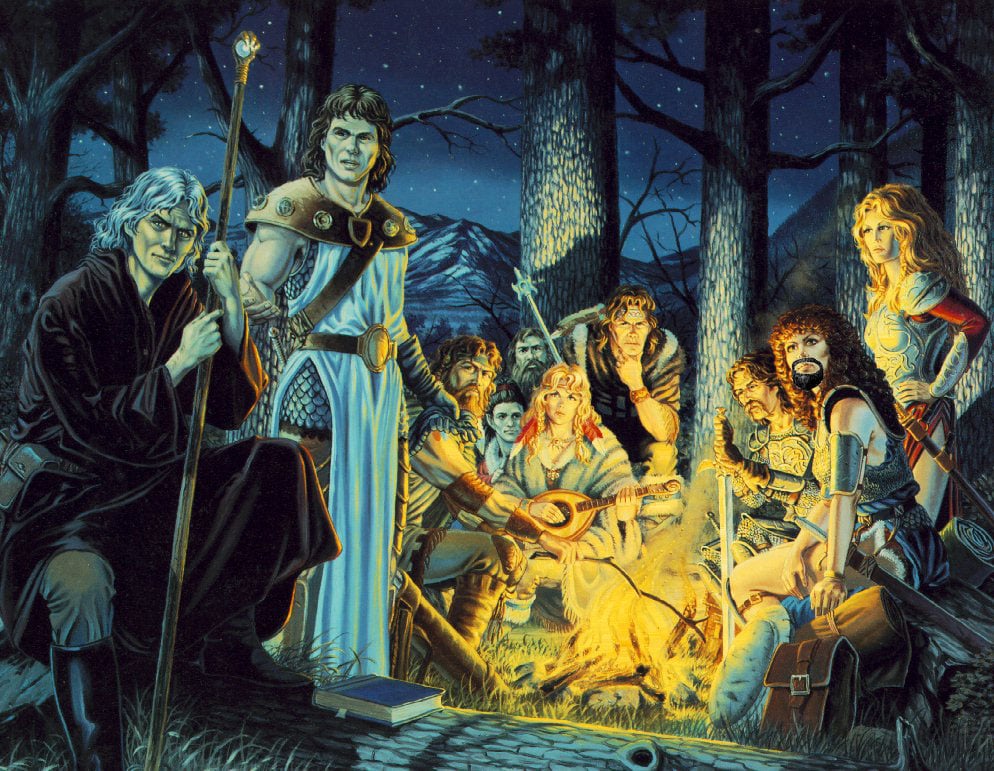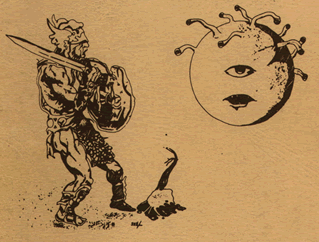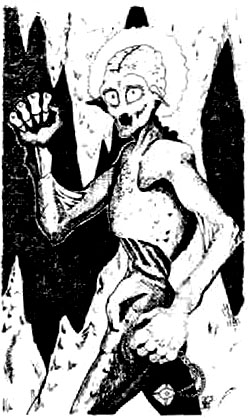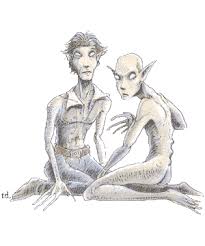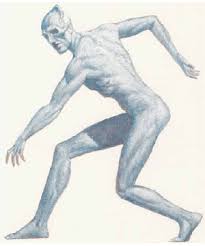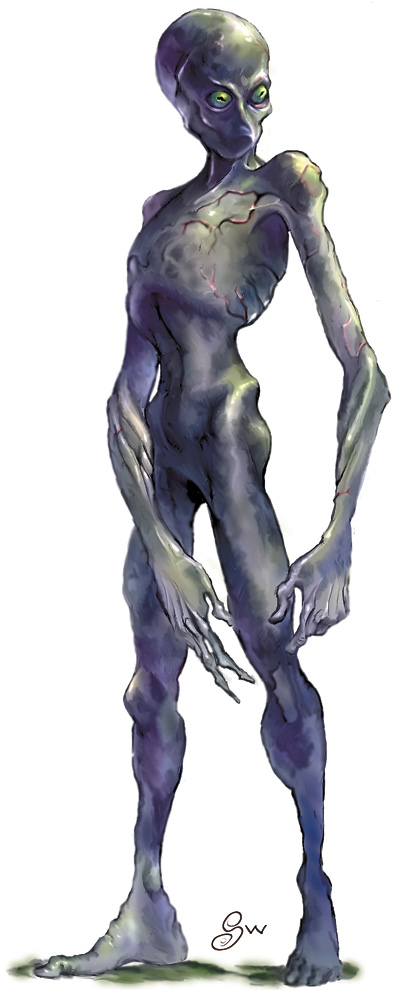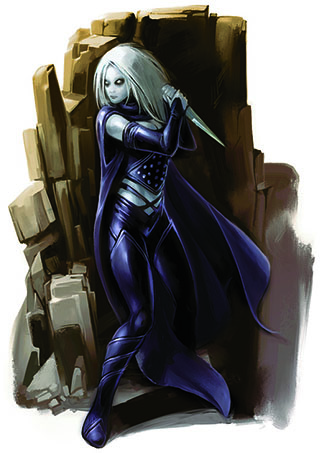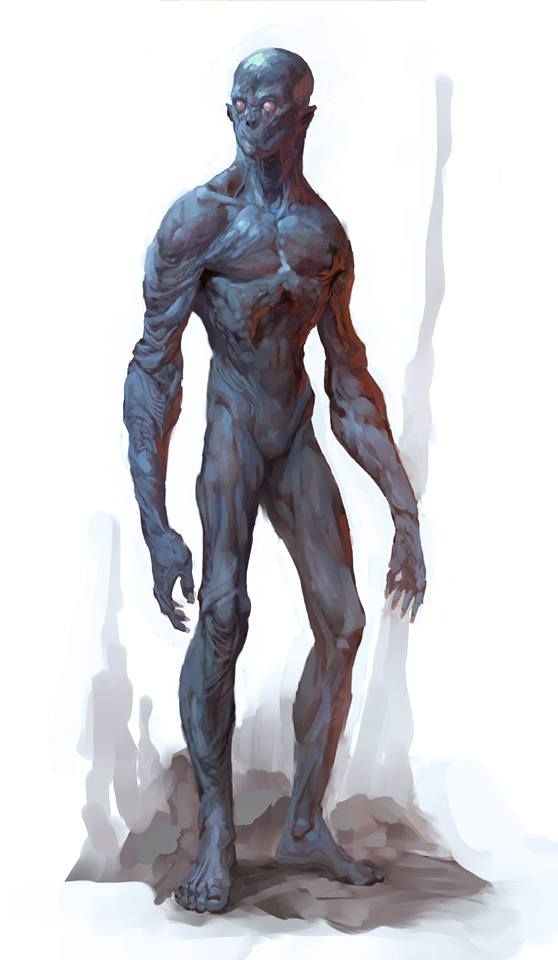Monster Spotlight: Doppelganger

Today’s monster is capable of impersonating anyone it sees. Even you…even…ME.
Wait! Don’t shoot! I know there are two of us, but you have to believe me. I’m the real one. No I am. No don’t listen–look I can prove it. Ask me anything! I can tell you all about how for this week’s monster spotlight we went into the deepest reaches of the Underdark and the Shadowlands in search of today’s monster, only to find that it had been living among us all the time. But it’ll will all come to light when we drag today’s monster into the spotlight! No, I’m the one that says that–guys it’s me, you have to believe me–that’s exactly what a doppelganger would say.
One of these heroes is a doppelganger in a cunning disguise, can you figure out who?
Doppelgangers are the gift that keeps on giving. There’s the initial encounter, of course, but then there’s the paranoia that sets in and colors any and all future encounters. Was that person truly who they seemed to be?
Doppelgangers have been around since the very beginning of D&D, which makes sense given their mythological origins. Much like Kobolds, or even the Tarrasque, doppelgangers had a storied place in folklore long before the first adventurers were kicking in the doors of Castle Greyhawk. As you might expect, the word is German in origin, even if the creature itself isn’t–Doppelganger was made popular in The Night Side of Nature, but the concept of a look-alike or spirit-double can be found in ancient Egyptian and Nordic mythologies.
And of course the idea of an “evil twin” is also nothing new, explored in such literary endeavors like Prometheus Unbound and William Wilson, but also from various real life anecdotes. People have claimed to see the doppelganger of people who died the day they did (despite being miles away). The idea of someone you know being somehow strange is a fascinating part of the psychological spectrum. It speaks to our own insecurities–after all the only person you can really ever be sure of is yourself. You can trust in other people, but you can never really know.
Thus, the doppelganger. And especially given Gary Gygax’ love of using monsters with surprising tactics (some might say gotcha! mechanics, even), they were a perfect fit for D&D. A monster that could take on the form of a trusted ally or even party member is the perfect tool for sowing chaos among the party. Which is probably why they appeared in those hazy proto-1st Edition days of the Greyhawk 1975 supplement, which features everyone’s favorite over-it Beholder.
Yeah sure, you have a sword and want my treasure. Whatever.
The first Doppelganger were pretty beefy, with a single d12 claw attack and a parcel of resistances:
DOPPLEGANGERS: These are creatures with mutable form, able to shape them- selves into the double of any person that they can observe. Once in this likeness they will attack—or if possible assume the role as well as the shape, and attack by surprise and at great advantage. Dopplegangers are subject to neither Sleep or Charm spells. They are also magic-resistant, saving against all forms of magical attack as if they were 10th level fighters.
So super tough, magic resistant creatures that can kill and replace you and then use their position as you to ambush and kill all your friends. Yup, that sounds about right for D&D.
The 1st edition doppelganger was not that different from the original incarnation. Though it had a few more structured abilities, like being able to ambush any creature on a 1-4, as well as gaining ESP to imitate them with near perfect accuracy–their ESP gave them a 90% chance for successfully imitating their chosen target. As before they preferred to ambush and eliminate a single target, effectively replacing them–though if they couldn’t, they’d pull the ol’ can’t-tell-which-of-us-is-the-double maneuver and attack and sow confusion.
The 2nd edition doppelganger was mechanically largely unchanged, though their ecology was expanded considerably. Doppelganger gained an origin story that alleges they were artificial beings created by some godling, or more traditionally, a wizard did it. When not impersonating someone, they can typically be found in dungeons or their wilderness homes. They group together in bands who attack monsters or travelers and steal their food and treasure. When times are scarce, they hire themselves out as infiltrators, bandits, and guards to powerful wizards or thieves.
They even get a little bit of personality–described as greedy and cowardly, valuing gold and wealth above all else. They would attack the richest looking characters first–and would probably wait until the adventurers were heading out of the town to ambush them while they were weak.
2nd edition also introduced a number of variant doppelgangers, such as the Greater Doppelganger in the Forgotten Realms boxed setting–smarter, stronger, and with the ability to mimic spells and abilities of the creatures they see, as well as the ability to eat the brains of their victims to store their personality and memories for later. Or plant doppelgangers, who use their pods to ensnare victims in their pods, while creating podling duplicates that can act out in the world.
3rd edition doppelgangers were much more alien in appearance. Much more similar to grey aliens, these doppelgangers lost a little of their raw attack power–their single attack dropped from a d12 to a d6+1, and their ability to change shape became codified as a supernatural ability (meaning antimagic fields could dispel its transformation without question, which makes sense, but is a slight downgrade in general). Similarly their ability to read thoughts became the spell Detect Thoughts which they can use at will as though they were an 18th-level caster, but the DC to resist was only DC 13, so past level 3 or 4, odds are good the players won’t fail.
3rd edition also saw a preponderance of doppelganger and doppelganger like player options. Character adjustments were native to the monster manual, and when Eberron came out, it introduced the Changeling race, born of humans with distant doppelganger ancestry that served as spies and scouts and so on.
4th edition focused far more on the doppelganger as assassin than previous editions. As with other monsters, the doppelganger had a few different forms–the 3rd-level doppelganger sneak and the 8th level doppelganger assassin. Both of these were sneak attack-dealing foes who had a power they could use basically at will to grant themselves combat advantage against a target (ensuring they’d get their sneak attack bonus). The assassin had an ability called Cloud Mind which rendered it invisible to a target–keeping it safe as it stalked its prey.
5th edition doppelgangers look less sci-fi alien, bearing more of that fantasy alien/otherworldly creature mien. These doppelgangers are skilled ambushers, with abilities that grant them advantage and extra damage during a surprise round (presumably gained by shifting their shape), as well as the ability to read the surface thoughts of anyone within range (no save). And with two attacks, a single doppelganger could be a decent threat–and a pack of them, ever shifting, could sow all manner of chaos in a party.
So there you have it. The monster with a thousand faces (not literally, that’s a different article altogether), perfect for any time you need a spy, a sneak, or just an excuse to sow discord and distrust in the ranks of your players. Help keep them on their toes, make a foe seem a friend, and a friend seem a foe.
Happy adventuring! No that’s MY line…or is it?


